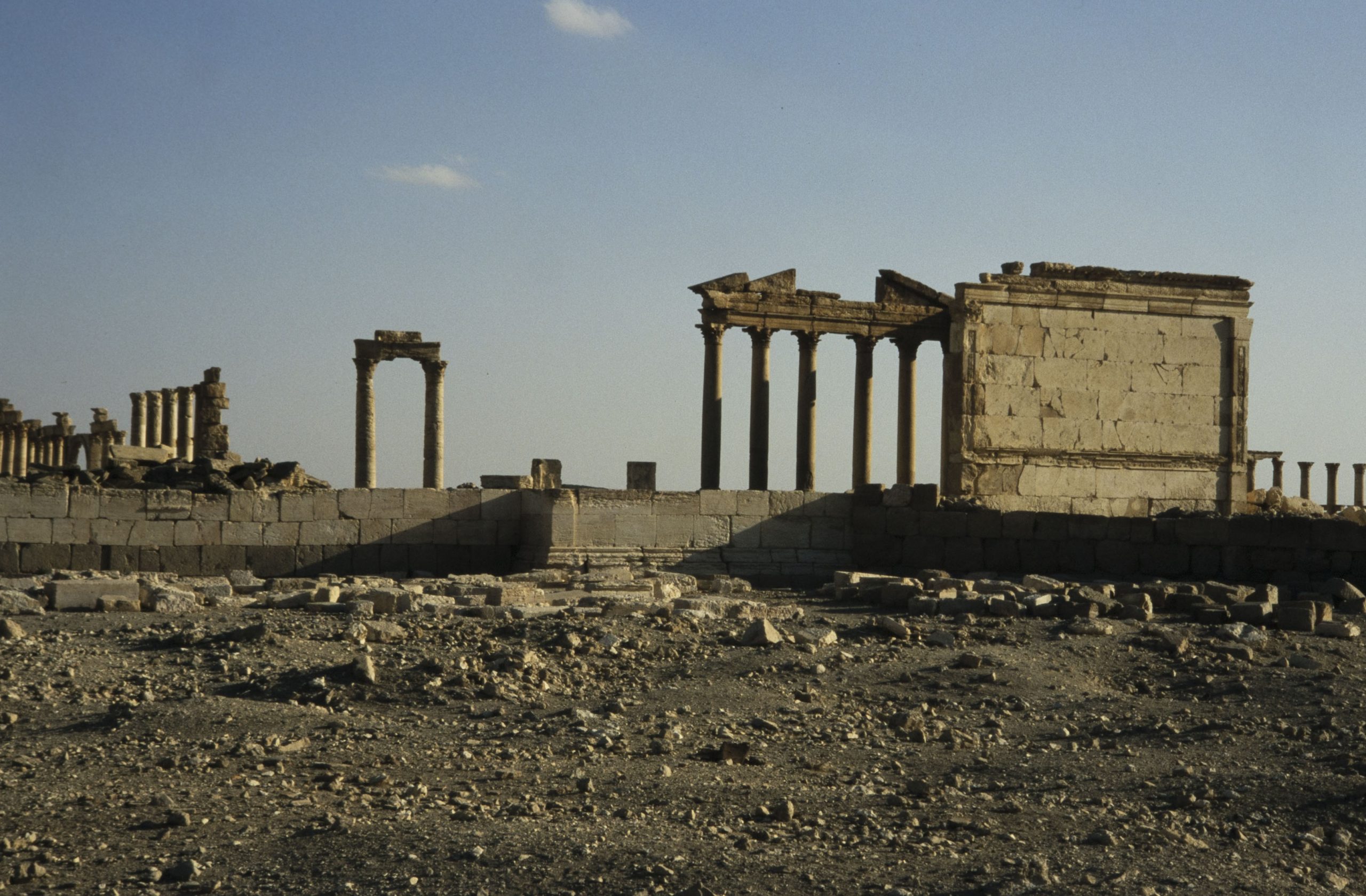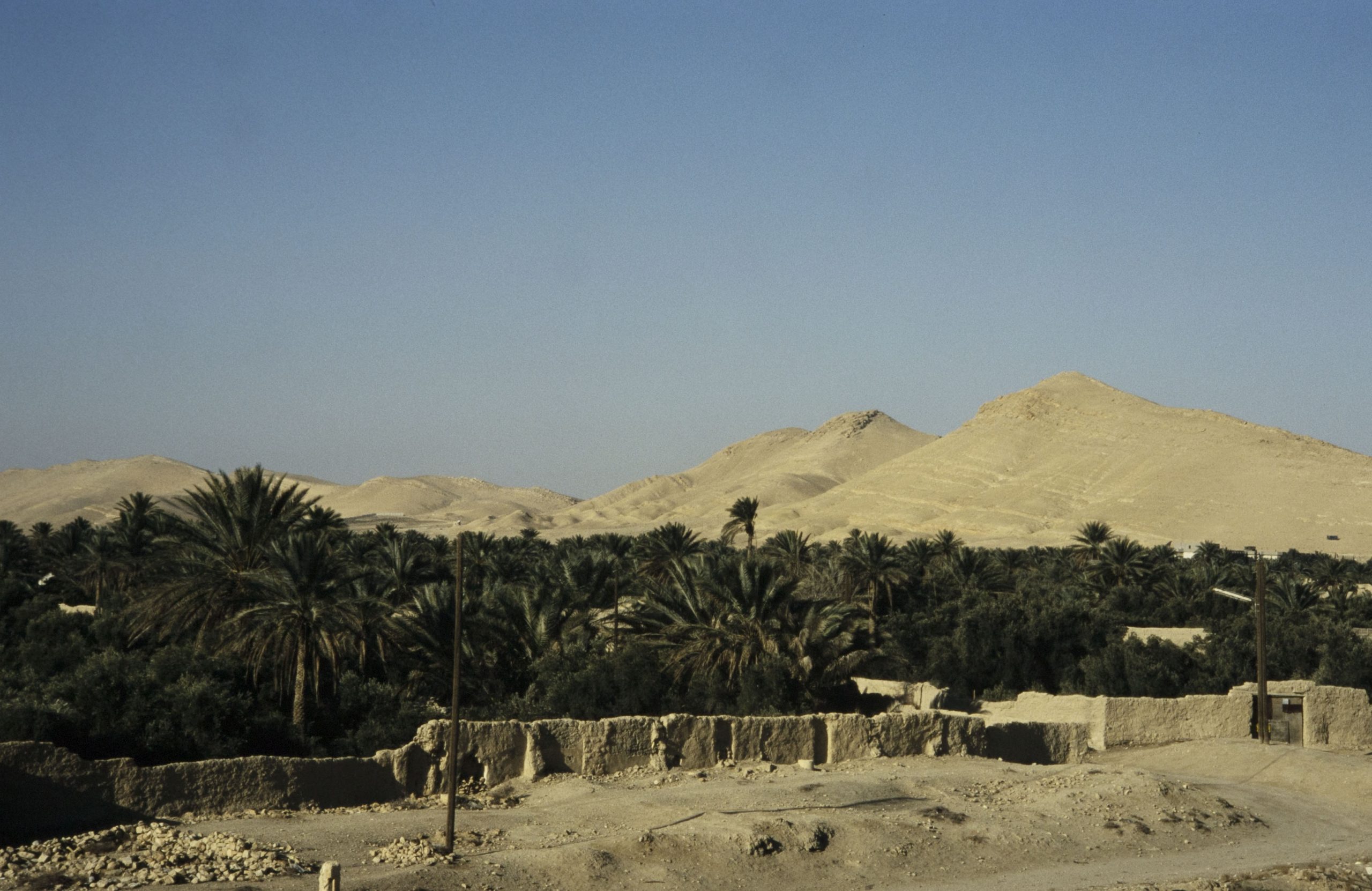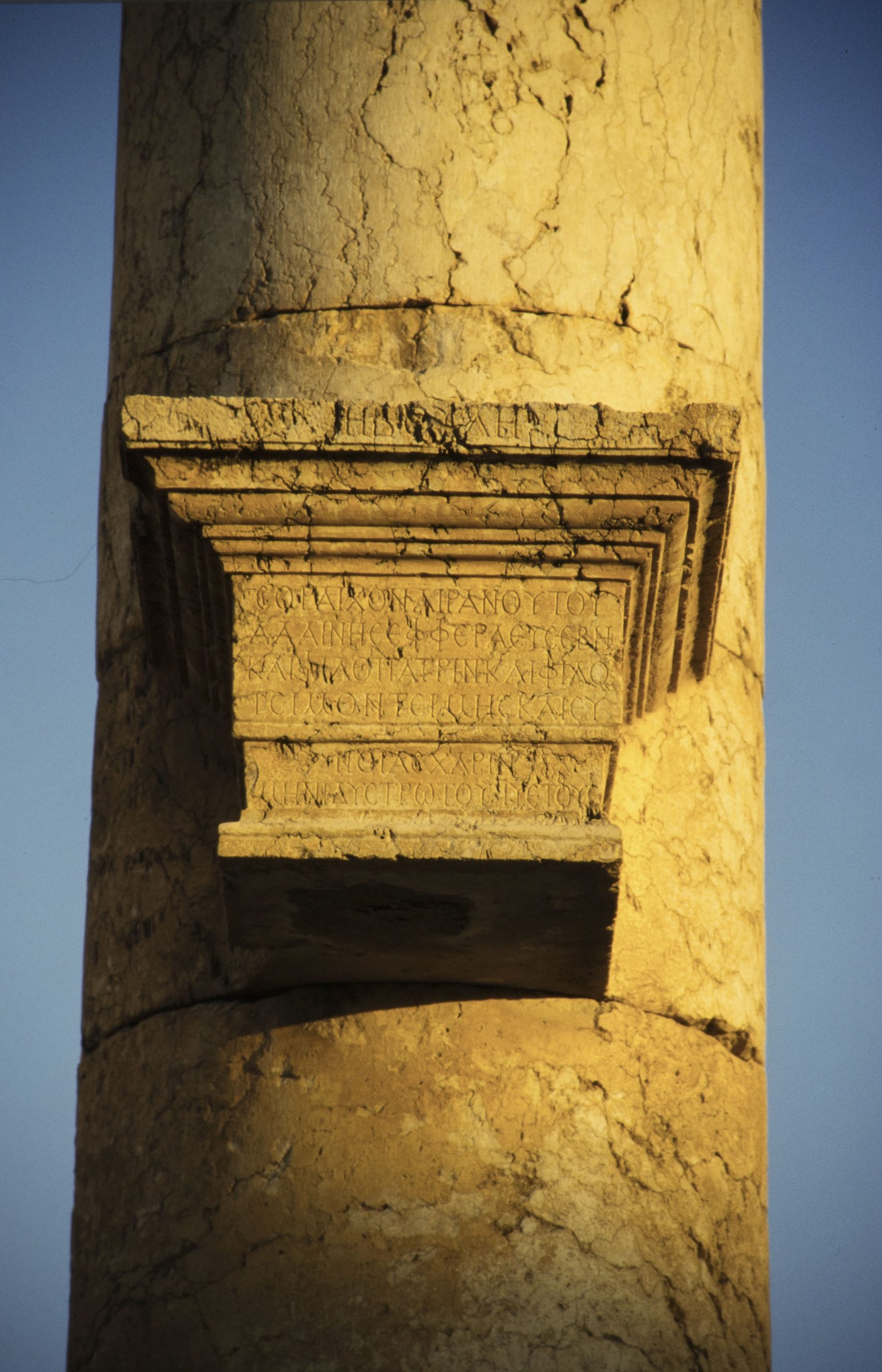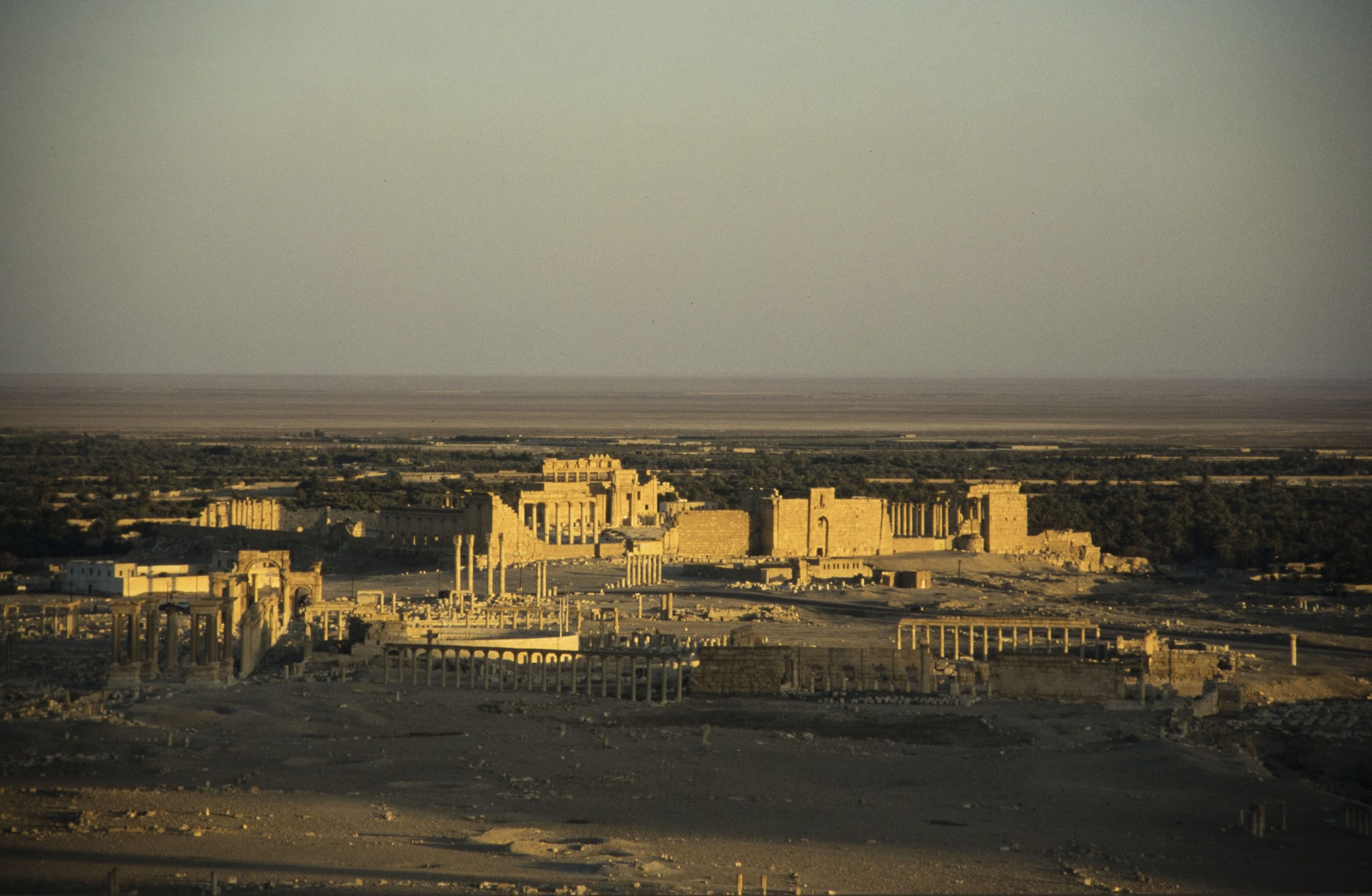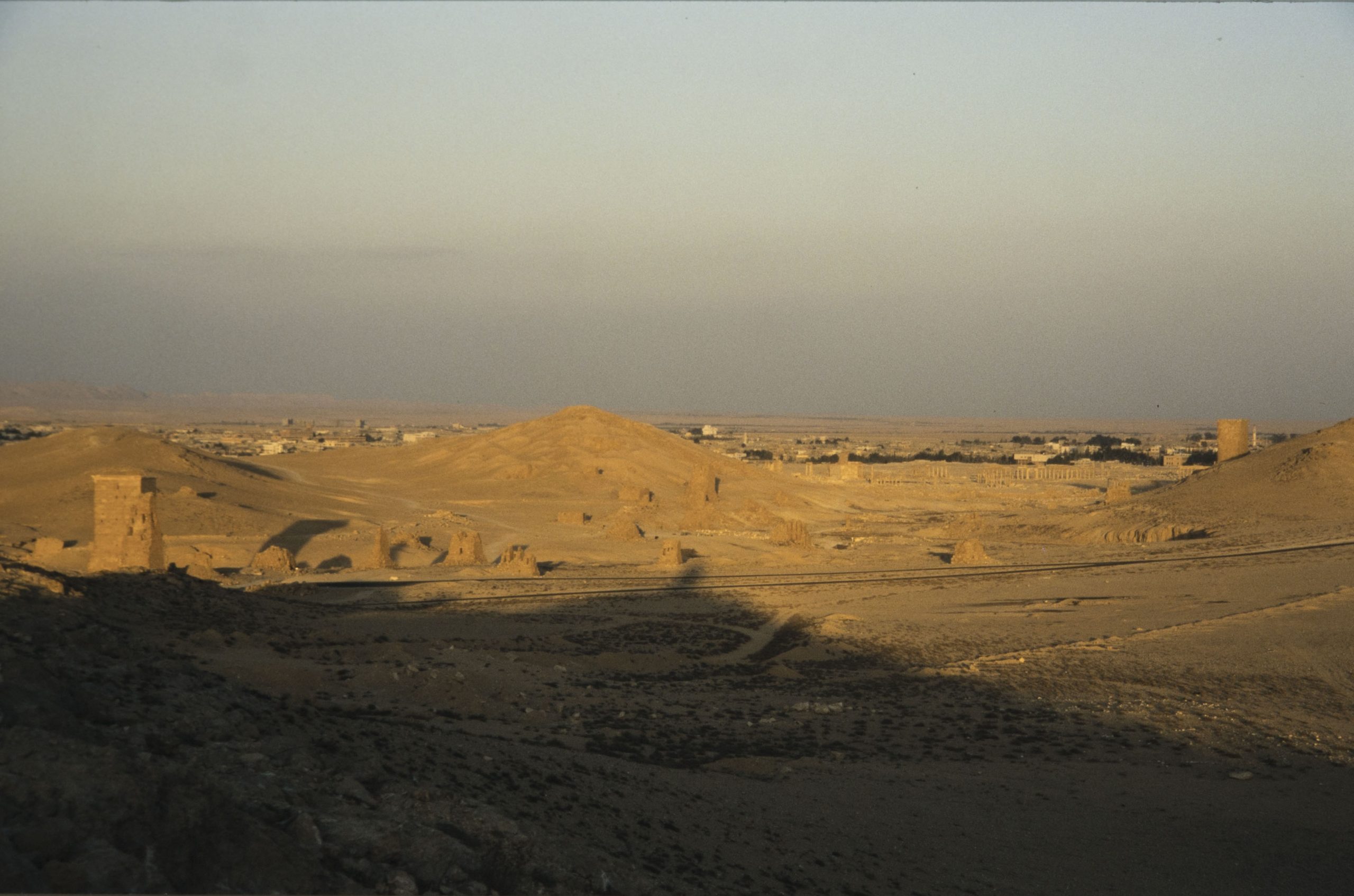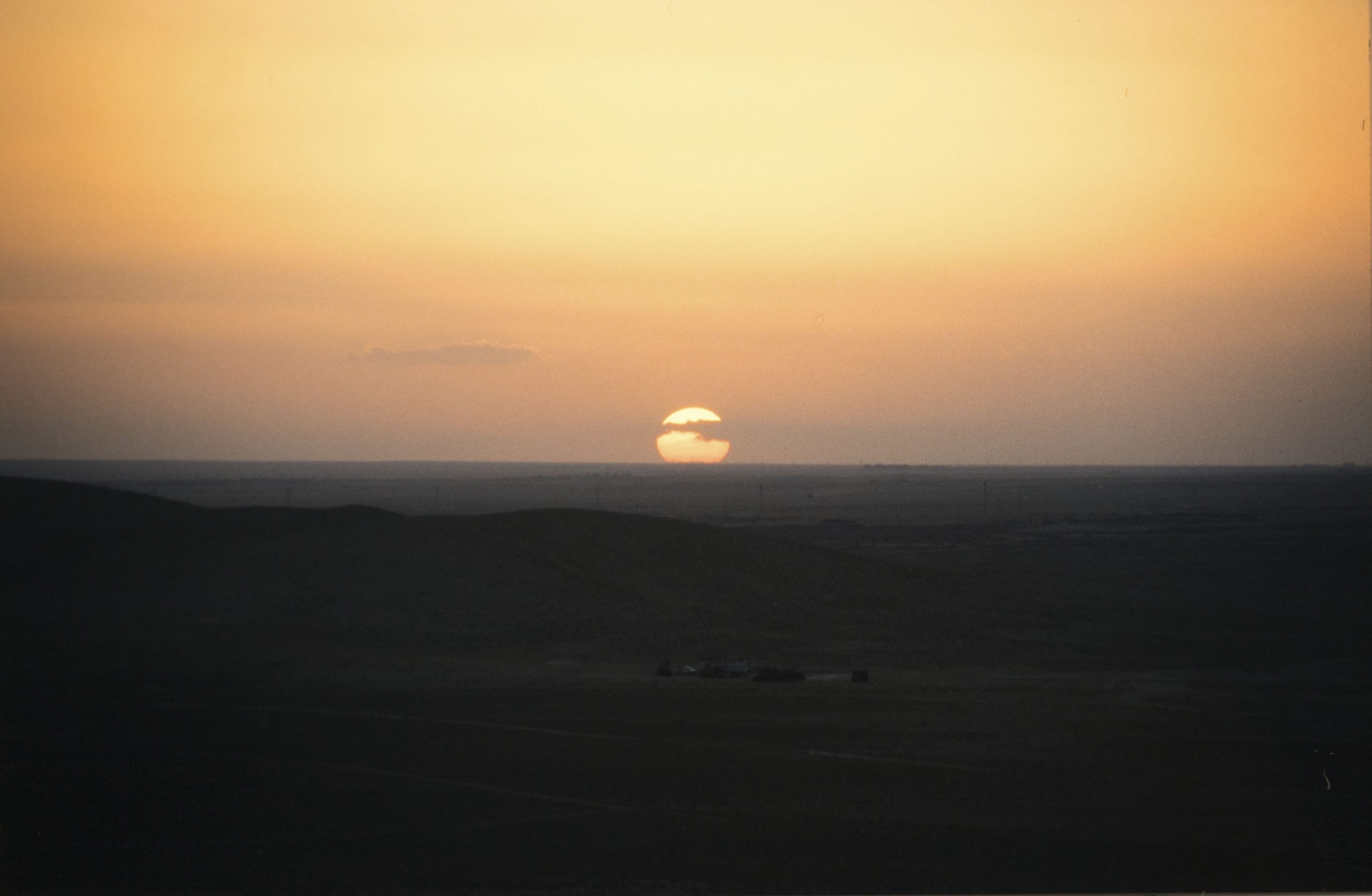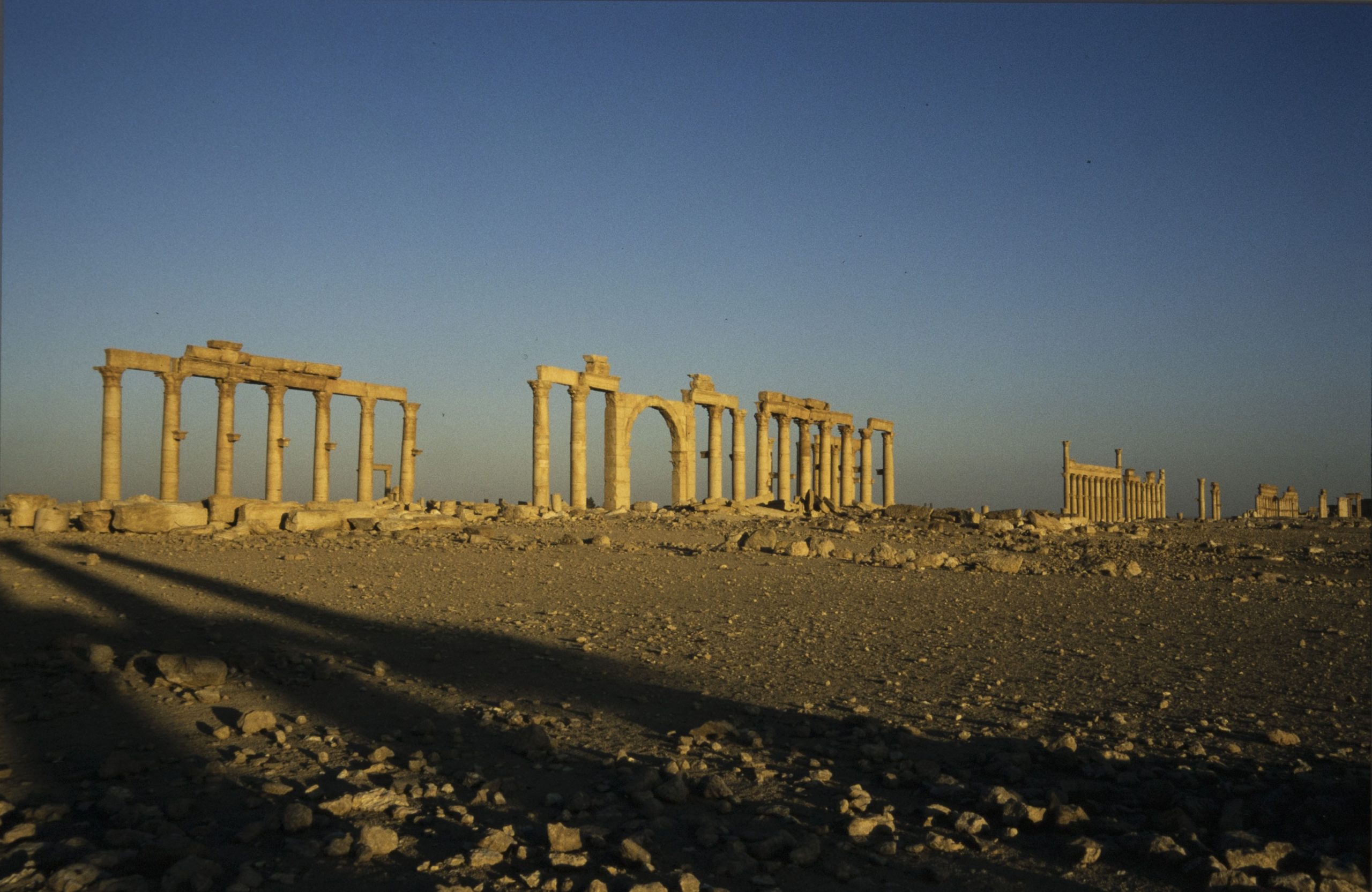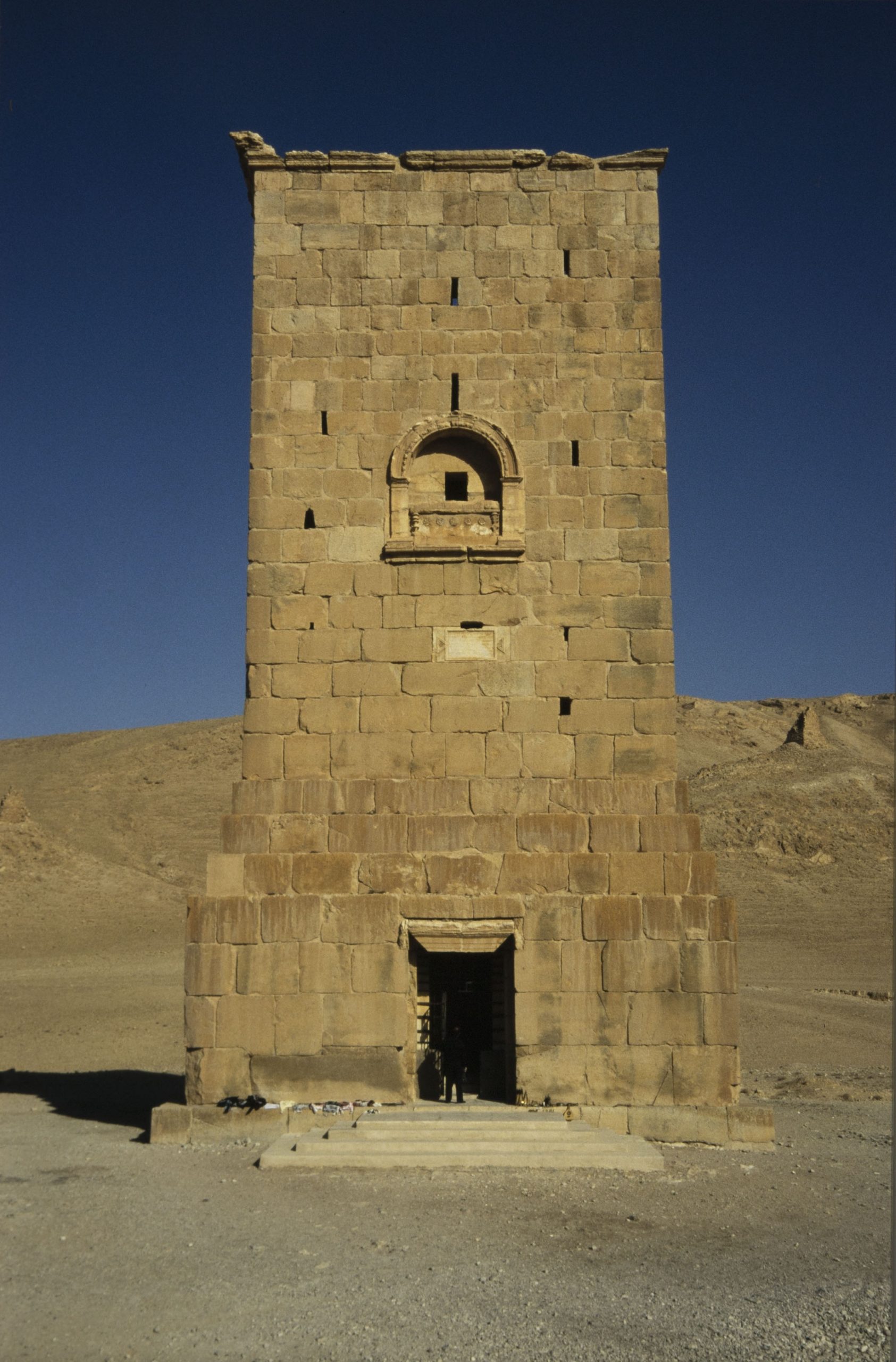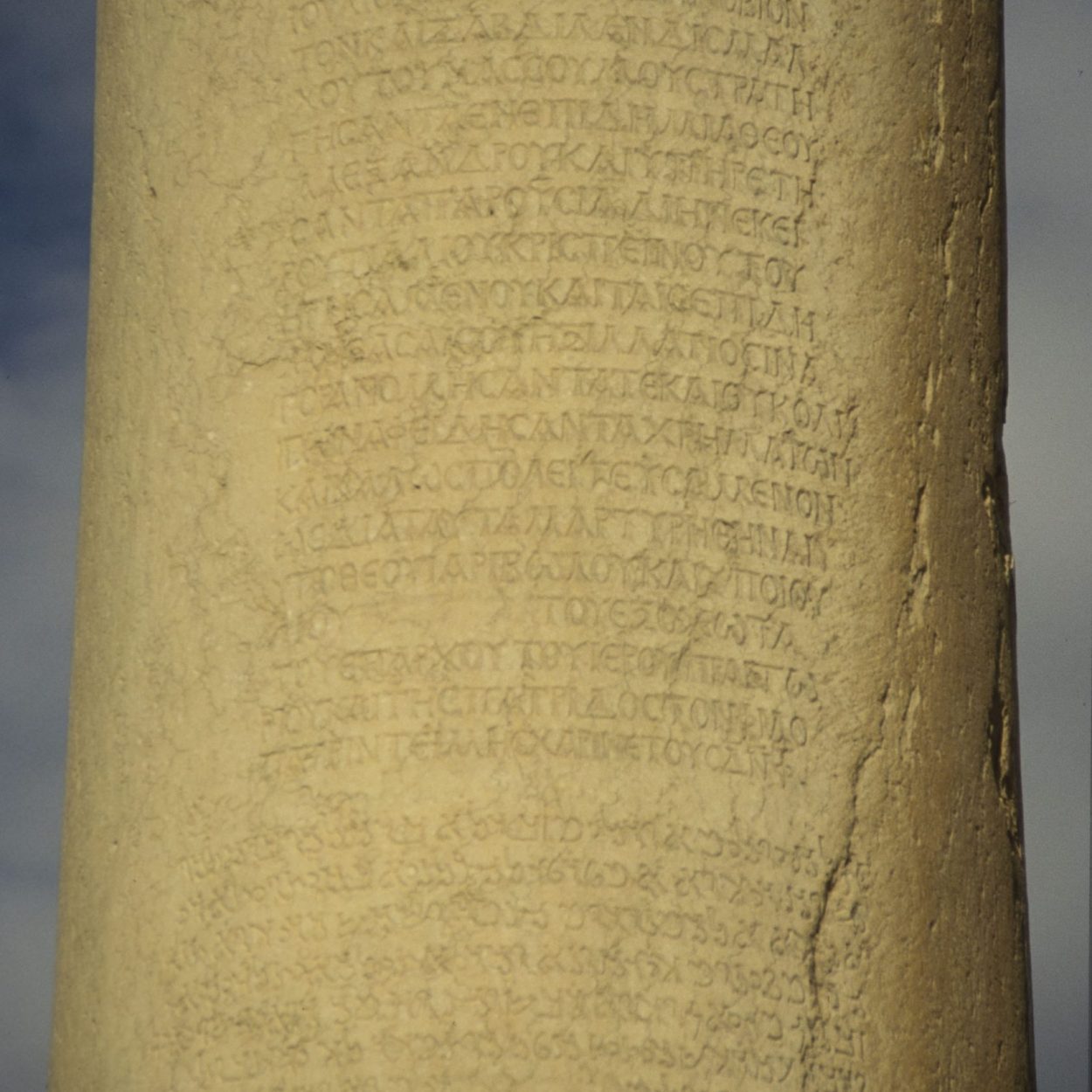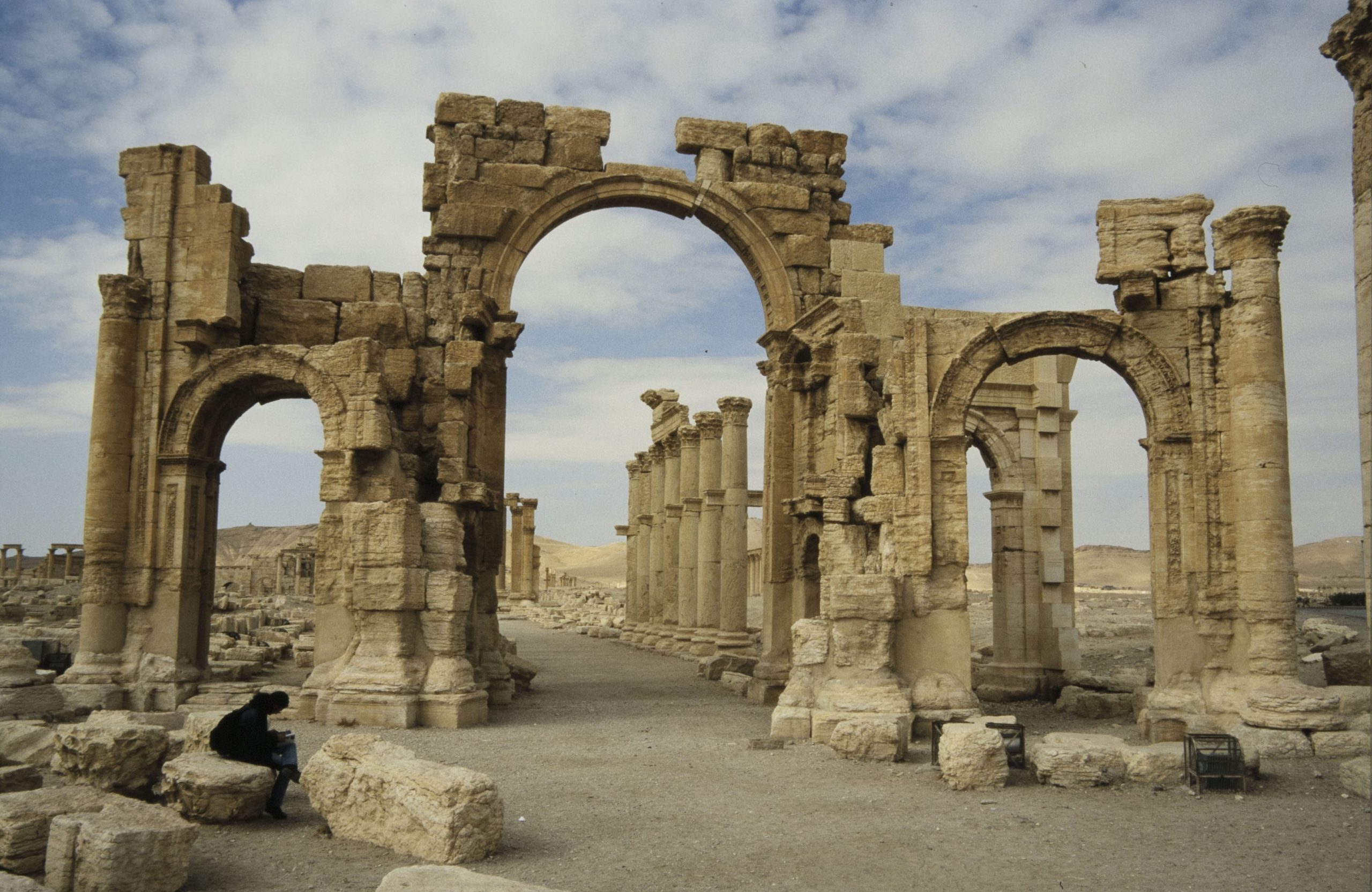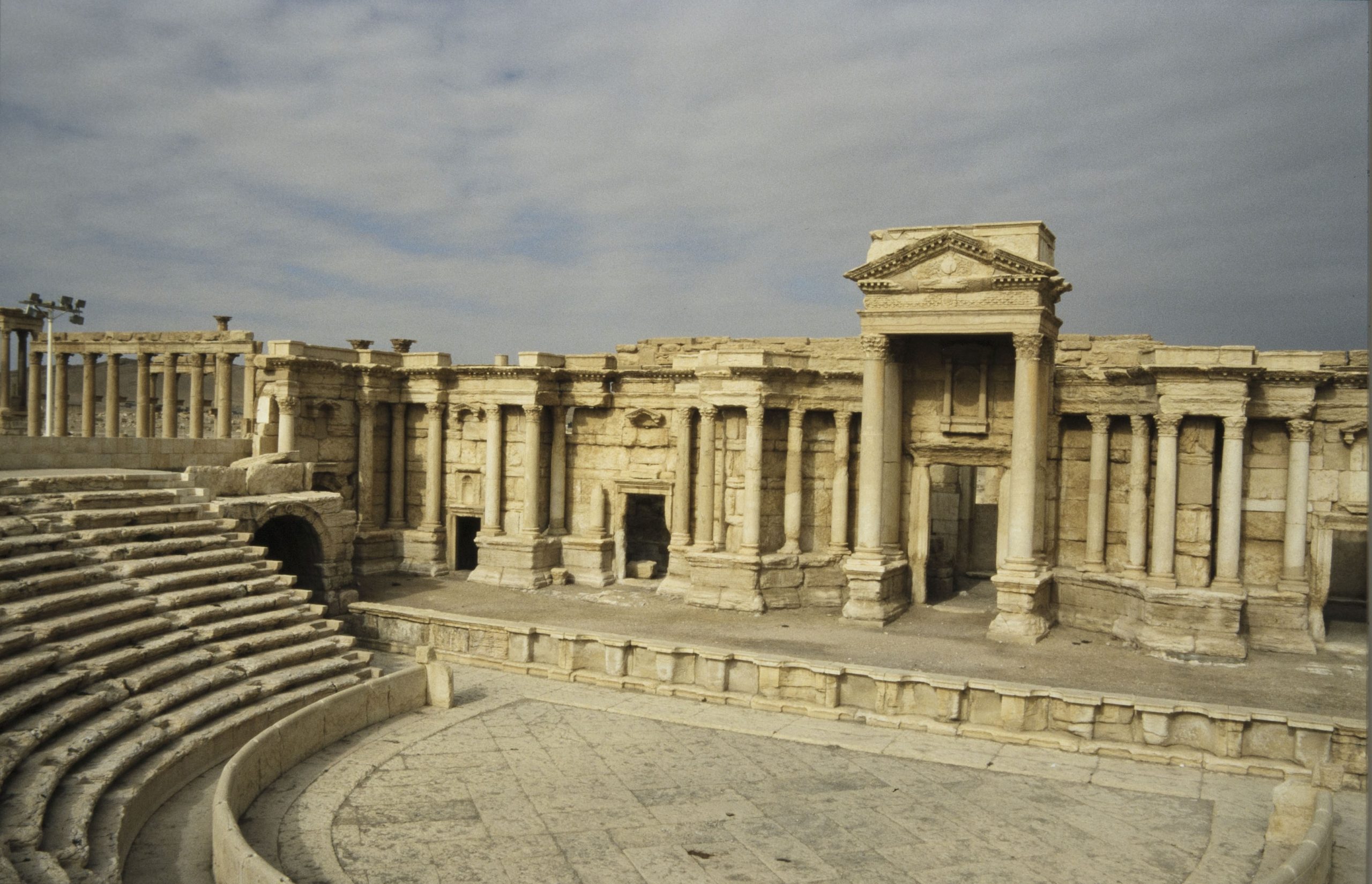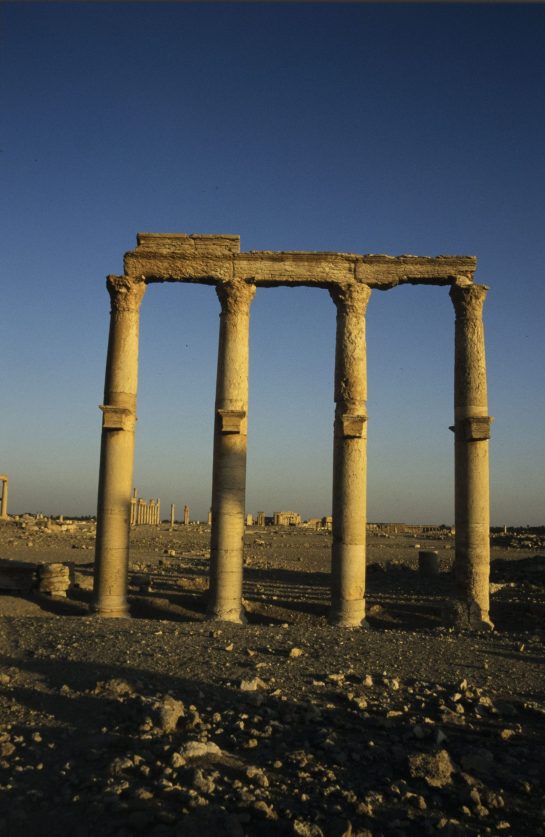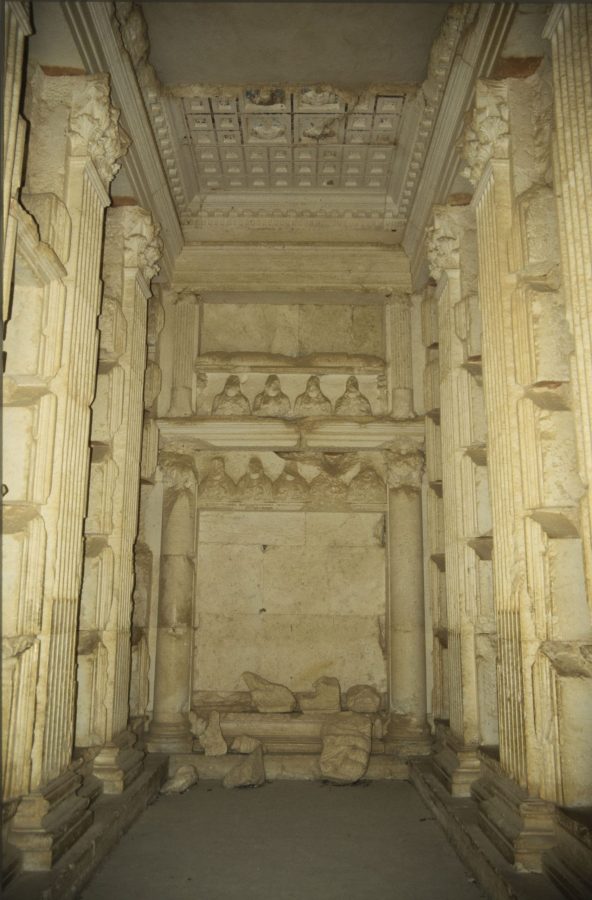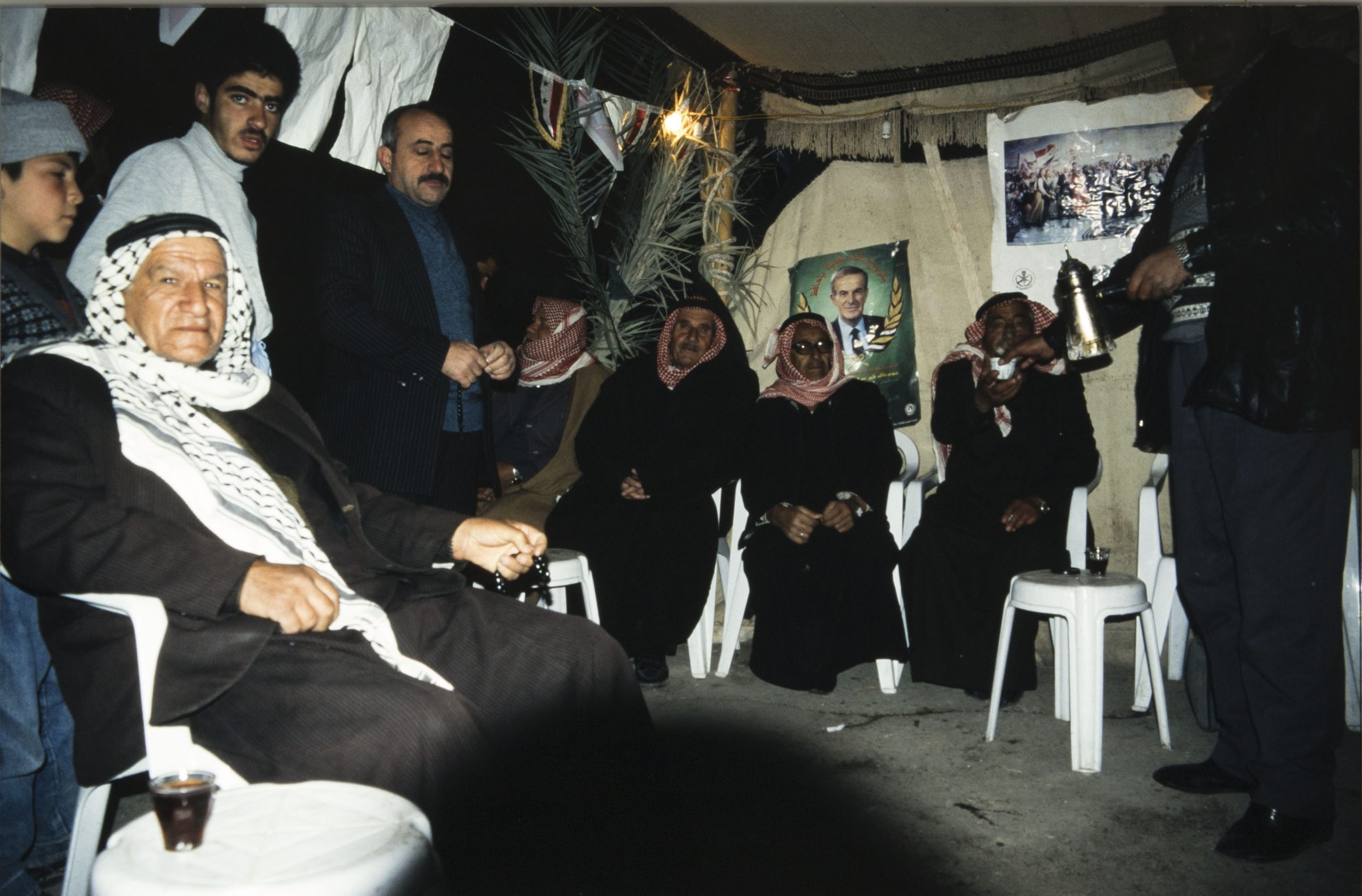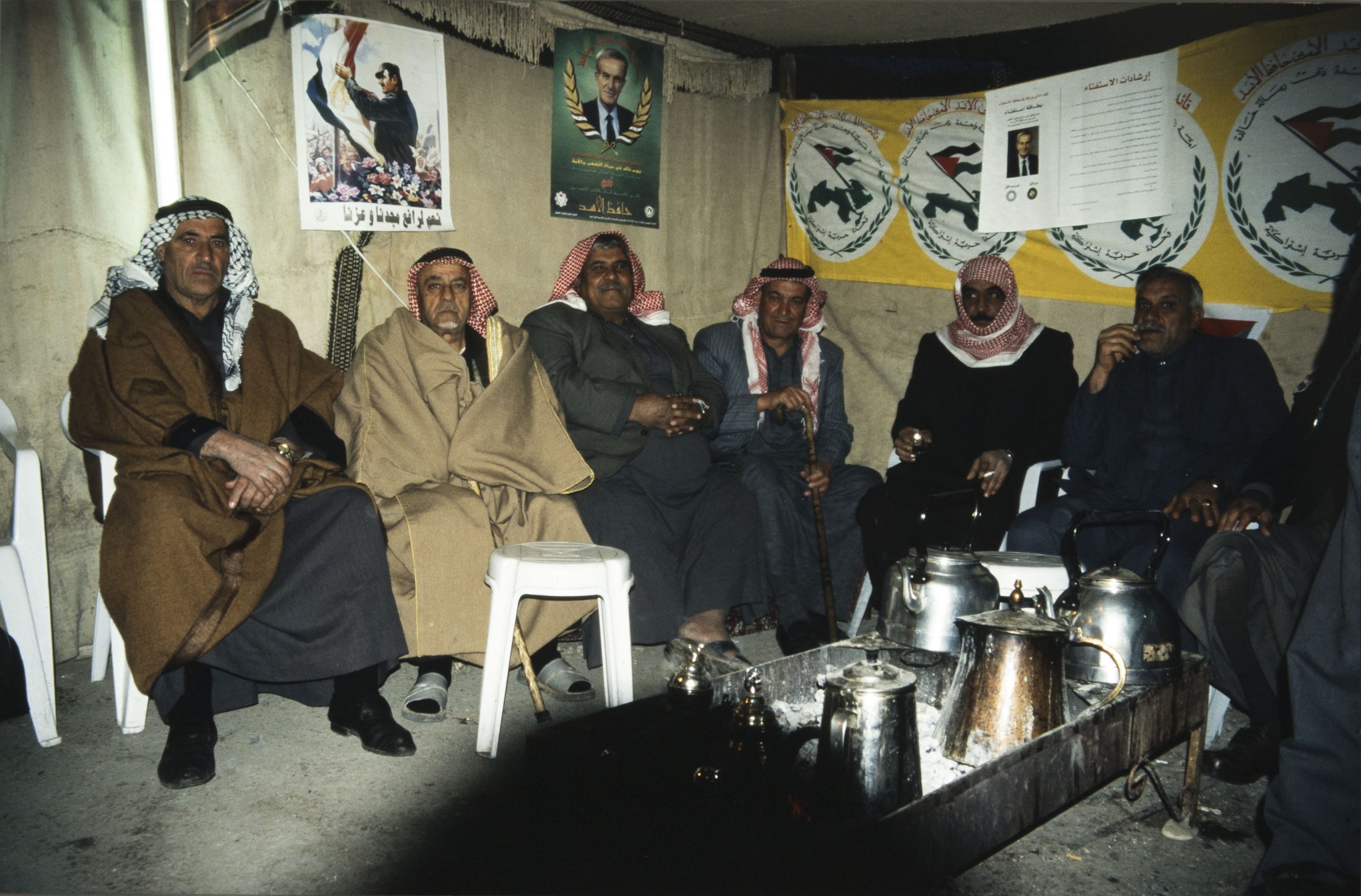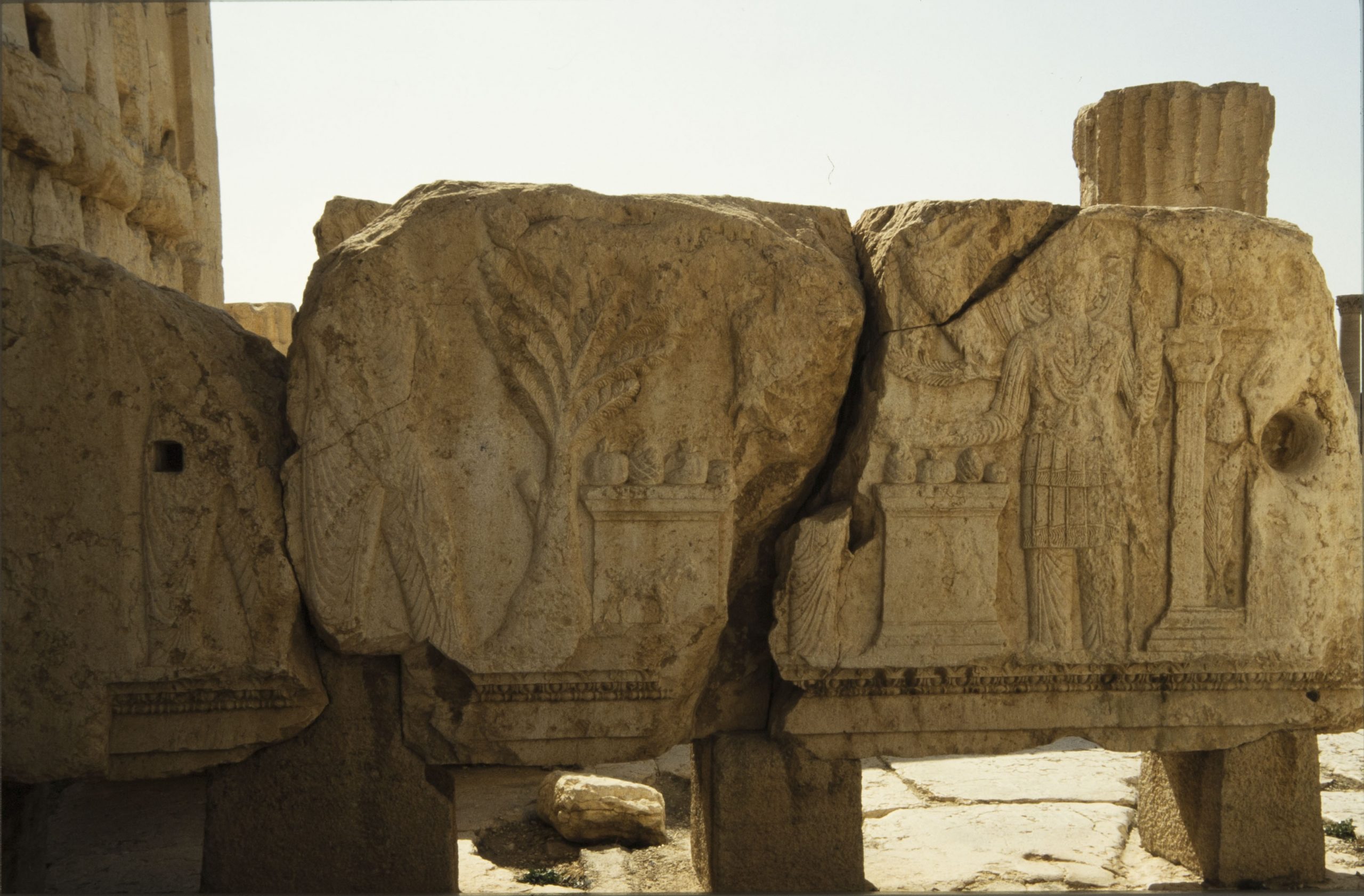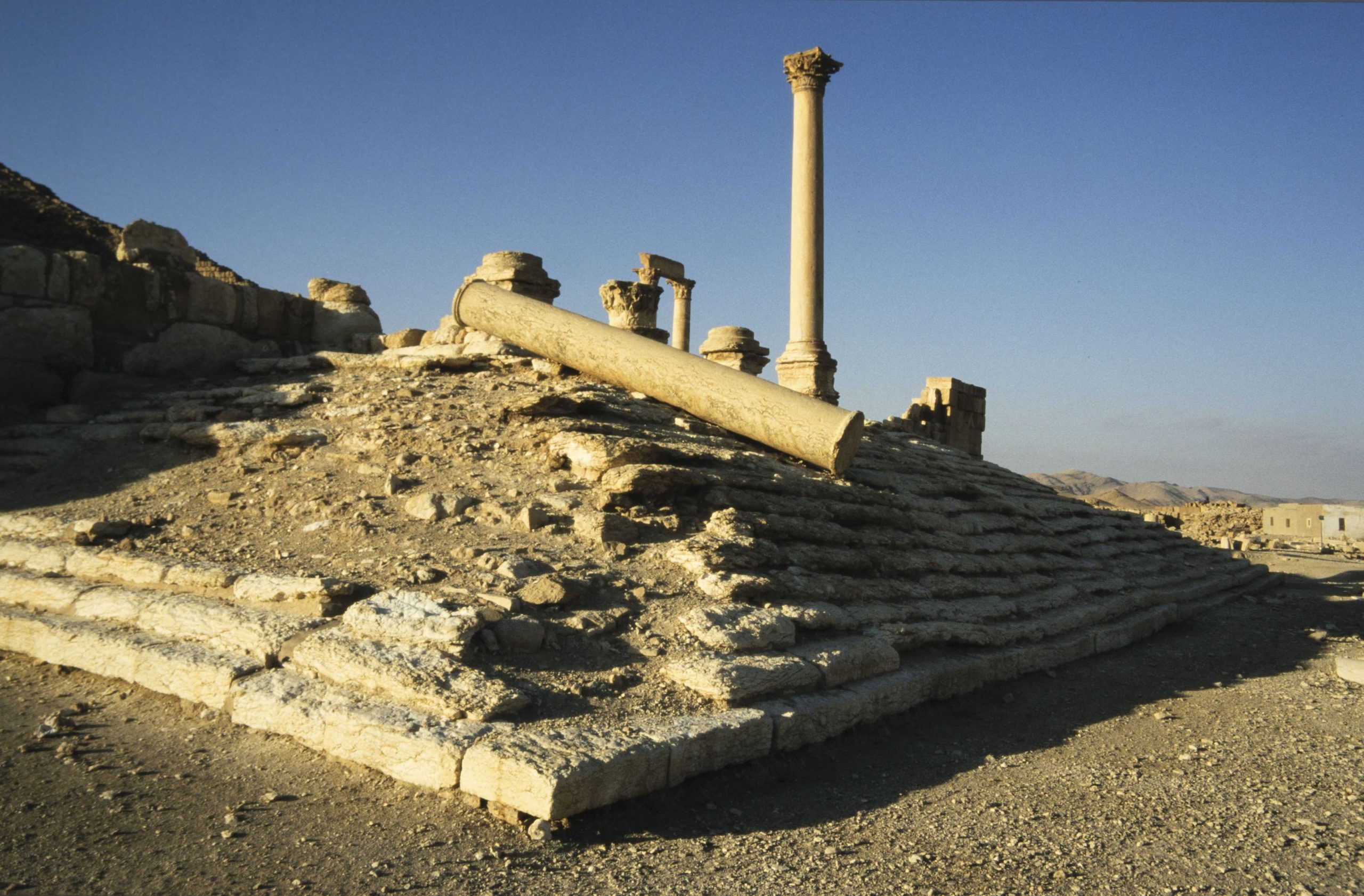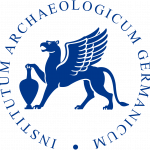PALMYRA | تدمر
When I saw that set of photos, my imagination was flying with every picture to the places on those pictures, and in my memory, the stories related to those places appeared, all of what I had experienced, and all the people of Palmyra were brought back to my memory.
For instance, the pictures of the Arab castle reminded me of my evening sport activities, which my comrades and I used to do. We were running up to the roof of the castle, so that we could enjoy how the buildings changed from yellow to pink during sunset, a scenery that steals your heart away.
The pictures of the destroyed houses adjacent to the northern city wall reminded me of the football matches we played every week. Most of the children of Palmyra took part, especially in the spring, when the earth was covered with green grass with a fragrant smell, which almost did not leave our noses.
The photos of the oasis always evoke in me the image of tired parents returning from their farms on their donkey carts, carrying with them clusters of dates, some of which were distributed to people passing by.
by Hasan – archaeologist / 07-04-2020
عندما شاهدت مجموعة الصور تلك، كانت مخيلتي تطير مع كل صورة إلى مكان تلك الصورة، وتعيد في ذاكرتي سحر ذلك المكان، والذكريات التي عشتها،
سواء أنا أو سكان تدمر الأخرين.
فمثلاً صور القلعة العربية، كانت تذكرني برياضتي المسائية أنا ورفاقي، عندما كنا نصعد جرياً إلى سطح القلعة، لنستمتع بتحول المباني من لونها الأصفر
إلى اللون الوردي، الذي يسرق القلب.
كما أن صور البيوت التدمرية المجاورة للسور الشمالي، كانت تذكرني بالمباريات التي كنا نلعبها أسبوعياً، أنا ومعظم أطفال تدمر، وخصوصاً في فصل الربيع،
عندما تكتسي الأرض بالعشب الأخضر ذو الرائحة العطرة، التي لا تكاد تفارق أنوفنا، أما صور الواحة فهي دائما تذكرني بصور الأباء المتعبين، الذين يعودون
من مزارعهم على عرباتهم، التي تجرها الحمير، ويحملون معهم عناقيد التمر، التي كانت تذهب بعضها في التوزيع على الناس الماريين .
مشاركة حسن – أثري/ ٠٧ – ٠٤ – ٢٠٢٠
THE NATURE OF LIFE IN PALMYRA
Water and the oasis were the focal points of our lives in Palmyra. It is a remote city in the desert and its nearest neighbour-town (as-Sukhna) is 70 km away. The oasis is located to the south and east of the town of Palmyra.
Our work in Palmyra was seasonal depending on what could be done in the desert climate. Most of us worked in agriculture, building houses, construction works and excavation with foreign and Syrian archaeological missions that worked in Palmyra for a long time. When the city started attracting many tourists, people worked in hotels and organized touristic tours on camels’ back at the archaeological site. The spring of Afqaa was a Sulphur spring and was sacred to the ancient and modern Palmyrenes. The spring’s name was Aramaic and it was the reason for the existence of Palmyra. The spring originated from a deep cave from Mount Al-Mantar west of the Palmyra oasis; the inhabitants of the valley led the water in channels to water trees and plantations in the oasis. The people of Palmyra visited the cave for swimming and enjoying the warm environment.
طبيعة الحياة في تدمر
تمحورت حياتنا في تدمر حول المياه و الواحة فتدمر مدينة نائية في الصحراء و أقرب بلدة لها (السخنة) تبعد عنها ٧٠ كم. و تقع الواحة الجنوب و الشرق
من تدمر. أشغالنا في تدمر كانت موسمية تعتمد على ما يمكن فعله في هذا المناخ الصحراوي فمعظمنا عمل بالزراعة و بناء البيوت و أعمال البناء المختلفة
و التنقيب مع البعثات الأثرية الأجنبية و السورية التي عملت في تدمر طويلاً و بعد أن استقطب الموقع الكثير من السياح بدأنا بالعمل في المكاتب
السياحية و الفنادق و تنظيم الرحلات على الجمال في الموقع الأثري الخ.
نبع أفقا كان نبعاً كبريتياً و كان مقدساً عند التدمريين القدماء و الجدد على حد سواء. اسمه آرامي و هو سبب وجود تدمر. ينبع من كهف عميق من
جبل المنطار غربي واحة تدمر و قام الأهالي بجر سواقي منه لسقاية الأشجار و المزروعات في الواحة. كان أهالي تدمر يزورون الكهف للسباحة و الاستمتاع
بالبيئة الكبيريتية الساخنة.
SPRING OF WATER
The spring dried out in the 1990s because of excavations and explosions to construct the Meridian Hotel (Palmyra East) adjacent to the cave that led to the cracking of the upstream rock. As a young man, I used to work cleaning the main water source in the cave, extracting the stones and sediments with baskets and ropes to facilitate the flow of the spring. Later we were told that this removal or cleaning should not include removing the calcareous layer plastered on the stone, because this layer was designed to prevent the water from leaking into the rocks. In the course of the spring, there were three baths. Closest to the source was the men’s bath, which consisted mainly of archaeological remains, including steps and ruins along the stream of water, and it was open. It was followed by the women’s bath – two newly built rooms above the waterway. Followed by the wool bath, which was a square pool with each side not exceeding 8 meters, set up to wash wool. We used the perforated baskets made of palm fronds to wash the wool; washing meant to drop the basket in the water and remove it a number of times. We then hit the wool with a piece of wood (Mekhbata) until it was agreed that the wool was clean. Washing wool was a family work involving women, children and men.
نبع المياه
النبع جف في التسعينيات بسبب الحفريات و التفجيرات لإنشاء فندق الميريديان (بالميرا الشرق) المجاور للكهف و التي أدت إلى تكسير صخرة المنبع.
كنا و نحن صغار ننظف المنبع الأساسي داخل الكهف، إذ نستخرج الأحجار و الرواسب بالسلال و الحبال لتسهيل جريان النبع. قيل لنا فيما بعد أن هذا
التعزيل أو التنظيف يجب ألا يطول الطبقة الكلسية التي تكسو أحجار النبع لأن هذه الطبقة وضعت لتمنع تسرب المياه بين الصخور.
على مجرى النبع ثلاثة حمامات الأقرب منها إلى المنبع كان حمام الرجال و هو عبارة عن مساطب أثرية على مجرى النبع و هو مفتوح. يليه حمام النساء
و هو عبارة عن غرفتين بنيتا حديثاً فوق مجرى الماء. يليه حمام الصوف و هو بركة مربعة ضلعها لايتجاوز ٨ أمتار أنشئت لغسل الصوف. كنا نستخدم
السلال المثقبة المصنوعة من سعف النخيل لغسل الصوف و الغسل كان يعني انزال السلة في الماء و اخراجها عدداً من المرات، ثم يضرب الصوف بقطعة
خشبية (مخباطة) حتى يتم الاتفاق على نظافته. غسل الصوف كان عملاً عائلياً تشارك فيه النساء و الأطفال و الرجال.
LIFE IS PAST
West of the city of Palmyra, there is a site called Abu al-Fawares, where the Palmyrenes established their farms. These farms were watered by wells dug in the area. We determined the location of a well in a way that depended on a branch of a pomegranate tree. We would cut off a green branch and put it in our two hands near our chest and leave the other side free and walk quietly until the free tip started to shake. The vibration of the branch was evidence for the presence of water under it and the intensity of the vibration was proportional to the amount of water and its proximity to the surface. The well was drilled around where the person holding the branch stood. This type of well is called jib in Arabic. It is a well dug by hand without plaster, and its sides are not paved with stones because the ground is rocky.
My grandfather and the rest of the people of Palmyra lived inside the walls of the Temple of Bell or in its immediate surroundings. Their house was located west of the temple, near a mosque named Al-Fadl. The houses were built with soil extracted on site, and wood was used for the roofs in combination with palm leaves, which were attached in the form of a mat and connected with strings and then covered with a layer of mud. The inhabitants remained in the temple until the French authorities issued a decision in 1928 of deporting the people living in the Temple area to new Tadmur, which at that time was called az-Zahira.
My grandfather moved with his family to a house in new Tadmur in the early 1930s. Most of the houses in the Temple of Bell were demolished. The French authorities gave each family a 1,000-square-meter plot of land as compensation, and four plots were grouped together in a square surrounded by streets.
After a number of those squares runs the main street. The French planners chose a chess-like grid system for Tadmur az-Zahira and we were impressed by this plan, which began to change after the departure of the French from Syria.
Tadmur az-Zahira is located on the shallow plain of Abu al-Fawares. In the Roman period, a water channel was drawn from Abu al-Fawares but disrupted in later periods The people of Palmyra used the water of the Abu al-Fawares spring to irrigate the nearby orchards before a drastic drop in the water level in later decades. The Abu al-Fawares archaeological channel led water from the spring to the ancient city; the transfer of water was carried out in pottery pipes mounted on the pillars of the Straight Street. The channel ended in the Nymphaeum/ Mermaids temple in front of the Arc de Triomphe. I saw the remains of these pipes near the columns. The archaeological site was very close to the hearts of the Palmyrenes even if they did not realize its historic and archaeological significance. We were missing the time when we lived in the temple of Bell. Most if not all the people of Palmyra prefer to stroll near the archaeological ruins between the theatre, the Arc de Triomphe, and the rest of the monuments. We would love to look at the remains of our ancestral civilization and love to sit in the shadows created by these buildings and monuments.
الحياة قديماً
غرب مدينة تدمر موقع يسمى أبو الفوارس و فيه أنشأ التدمريون مزارعهم ، تروى هذه المزارع بالآبار المحفورة في المنطقة.كنا نحدد موقع البئر بطريقة
تعتمد على غصن من شجرة رمان. كنا نقطع غصناً غضاُ و نثبته بيدينا الاثنتين قرب صدرنا و نترك طرفه الآخر حراً و نمشي بهدوء إلى أن يبدء الطرف الحر
بالاهتزاز. اهتزاز الغصن كان دليلاً على وجود الماء تحته و تتناسب شدة الاهتزاز طرداً مع كمية المياه و قربها من السطح. يتم حفر البئر حول مكان
الشخص الممسك بالغصن و يسمى هذا البئر (جب عربي) و هو بئر محفور باليد و لا يجصص و لا ترصف أطرافه بالحجارة لأن التربة المحفور فيها صخرية.
كان جدي و معه باقي أهالي تدمر يقطنون داخل معبد بل و ما حوله، و بيتهم كان غرب معبد بل قرب جامع اسمه الفضل. أما مواد البناء التي
استخدمت في بناء بيوت المعبد فهي التراب المستخرج من الموقع, والأخشاب المستخدمة في الأسقف مع الاستعانة بجريد النخل، الذي كان يشبك على
شكل حصيرة و يربط بخيطان ثم يغطى بطبقة من اللبن (الطين) المدحول.
بقي الأهالي يقطنون في معبد بل حتى أصدرت السلطة الفرنسية آنذاك قراراً في عام ١٩٢٨ م , ينص على ترحيل الأهالي إلى البلد الجديدة و المدعوة
بالبلدة الظاهرة. خرج جدي مع عائلته إلى بيته التدمري الجديد في أوائل الثلاثينيات من القرن الماضي . و قد تم هدم معظم البيوت في معبد بل. عوضت
السلطات الفرنسية كل عائلة بقطعة أرض مساحتها ١٠٠٠ م ٢ و تم تجميع كل أربع أراضي معاً في مجموعة تحيط بها الشوارع. و بعد عدد من المجوعات
تأتي الشوارع الرئيسية. لقد اختار المخططون الفرنسيون تصميماً شطرنجي الشكل لتدمر الظاهرة و كنا معجبين بهذا المخطط الذي بدأ يتغير بعد
خروج الفرنسين من سوريا .
تدمر الظاهرة منخفضة عن سهل مزارع أبو الفوارس لذلك تم جر قناة مياه إليها من أبو الفوارس) في الفترة الرومانية والتي تعطلت في فترات لاحقة) .
كما استغل أهل تدمر مياه نبع أبو الفوارس لري البساتين المجاورة قبل أن تغور في العقود المتأخرة.
قناة أبو الفوارس الأثرية كانت تجر مياهاً من نبع أبو الفوارس إلى المدينة الأثرية و تنقل المياه في أنابيب فخارية كانت محمولة على أعمدة الشارع
المستقيم و تنتهي في معبد الحوريات أمام قوس النصر. شاهدت بنفسي بقايا هذه الأنابيب بقرب الأعمدة.
الموقع الأثري قريب جداً إلى قلوب التدمريين حتى و إن لم يدركوا أهميته التاريخية و الأثرية كنا نحن إلى الوقت الذي سكنا فيه معبد بل. و معظم إنلم يكن كل أهل تدمر يفضلون التنزه قرب الآثار بين المسرح و قوس النصر و باقي الصروح. كنا نحب النظر إلى بقايا حضارة أجدادنا و نحب الجلوس في
الظلال التي تخلقها هذه المباني و الآثار.
PALMYRA AND THE JINN
Most of us have stories with the jinn, perhaps because we lived close to these archaeological sites, and most of us thought that the souls of those who lived there were still present. I saw a jinni once when I was young. After I had finished my work in the orchard, I went to wash myself with water of Afqaa spring, and I saw a black woman, who was very chubby, sitting on one of the pillars and nursing her baby. Her hair was fluffy. I was very scared and started to run to our house. When I told my grandfather, he told me that he was glad she did not hurt me; she is a well-known jinni, whose name was Umm Oweid. My grandfather was appointed as a guard of Madfan Al-Arous (the bride tomb, Elahbel tomb) by the Directorate of Antiquities. During his work in the tomb, he heard the sounds of celebrations and songs coming from the vault, which did not bother him until ‘they’ started to throw small stones at him. He then wanted to see what was happening inside, and saw a jinni staring at him on the stairs in the shape of a cow. He ran home in panic, leaving the tomb he was guarding unattended, and retired from doing this work altogether.
by Faisal – worker / 25-06-2019
التدمريون والجن
لمعظمنا قصص مع الجن ربما لأننا كنا نعيش قريباً من هذه الأوابد الأثرية التي ظن معظمنا أن أرواحاً لازالت تسكنها. عن نفسي رأيت جنية مرة واحدة
عندما كنت صغيراً. بعد أن أنهيت عملي في البستان اتجهت لأغسل نفسي بمياه سواقي أفقا و اذ بي أرى امرأة سوداء عارية شديدة البدانة تجلس على
إحدى العواميد و ترضع طفلها. كان شعرها منفوشاً فخفت منها كثيراً و بدأت بالركض إلى بيتنا. عندما أخبرت جدي قال لي أنه مسرور بأنها لم تؤذيني
فهي جنية معروفة هناك اسمها أم عويد.
جدي نفسه عين حارساً لمدفن العروس(مدفن إيلا بل) من قبل مديرية الآثار و كان اسمه العماوي. و خلال حراسته للمدفن و عدة التنقيب فيها سمع
أصوات احتفالات و أهازيج قادمة من المدفن الأمر الذي لم يزعجه إلى أن بدؤوا بقذفه بالحصى الصغيرة فأراد أن يرى ما يحدث بالداخل، حينها رأى جنية
تنتظره على الدرج في شكل بقرة. من ذعره ركض إلى المنزل تاركاً المدفن الذي يحرسه و اعتذر عن هذا العمل كلياً.
مشاركة فيصل – عامل / ٢٥ – ٠٦ – ٢٠١٩
MY LIFE PLAN
Palmyra was the most influential and important turning point in my life. In the summer of 1999, after high school exams had ended, I was nominated to participate in a youth camp in Palmyra. It was the first time that I left Aleppo. On our way to the campsite, the golden sunlight struck the sand, reflecting an indescribable light, as if the columns and ancient buildings derived their colour from that light over time. It was the first time that I met young men and women from outside Aleppo, who were from all the Syrian governorates, different dialects, professions, ethnicities and religions. In short, all of Syria was in that camp. Our group was supposed to help excavating ‘the bride of the desert’. In the morning, we went to work, which was to participate in excavations with the joint Syrian-Japanese mission. Mr. Khaled Al-Assad was the director of the Syrian site. During the work, we found heads of statues. I think on the first day the discoveries comprised more than ten heads of statues, some had writings on them. I felt happiness whenever we found a statue. Professor Khaled Al-Asaad came to read and immediately translate some of the writings for us. Then we returned to work. During the breaks, questions were asked to Professor Khaled by the students about Palmyra and its history and Syria in general. I was most curious, memorized what he was saying and returned the next day asking new questions. After a week, he invited me on a tour through Palmyra after work, taking me to the Arc de Triomphe. As we sat on the capitals of some of the scattered columns, the conversation that changed my life took place. Before Palmyra, I was planning to study law at the University of Aleppo. After this conversation, everything changed. He explained to me the story of his love for Palmyra and his attachment to it. Then he asked me, “What do you intend to study?”, so I told him “the rights”. “Jamil”, he said to me, “but there are thousands of jurists in Syria!” And he continued: “I noticed your interest in antiquities and your ability to quickly memorise information.” Then he added, “There is a Department of Archaeology at the University of Damascus that recently opened, which is a rare specialization in Syria and I think you will have a good opportunity there.” Then he stood up without hearing my answer – as if he did not want me to answer this question immediately. He continued to tell me about the Arc de Triomphe, the gallows, the tower burials, the caravans, Zanobia, and the burial rites. Every day I went to wander between Palmyra’s ruins, contemplating the “splendour of the daughter”, and when I was tired, I lay in the shadow of pillars. Everything was making me dream, remembering what Khaled had told me about Palmyra. The month ended and the thirty days had been the most beautiful days of my life. The camp ended and the bus came to take us to Homs. I could not hold myself and tears poured against my will … I left Palmyra in tears and sad, it seemed as though I was lovesick …, yes, I fell in love with Palmyra and its sands.
I returned to Aleppo and the moment I arrived I told my father that I had changed my mind and that I would study in the Department of Archaeology at the University of Damascus. My father rejected the idea completely, but that did not prevent me from insisting on what I wanted. I asked for the support of my mother and my uncle. Indeed, after a week of daily discussion, my father surrendered to what I wanted, and he said “To me, as long as this is what you want, so be it, but in the first year, if you do not achieve excellent results, I will be disappointed.”
خطة حياتي
تدمر كانت نقطة التحول الأجمل و الاهم في حياتي، في صيف عام ١٩٩٩ بعد انتهاء امتحانات الثانوية العامة، تم ترشيحي للمشاركة في معسكرٍ للشبيبة
في مدينة تدمر. كانت المرة الأولى التي أخرج فيها خارج حلب، في طريقنا لمكان المعسكر كان ضوء الشمس الذهبي يضرب الرمال فيعكس ضياءً لا يمكن
وصفه، كأن الأعمدة والمباني الأثرية استمدت لونها من ذلك الضياء عبر الزمن. كانت المرة الاولى التي التقي فيها بشبابٍ وفتياتٍ من خارج حلب، كانوا
من كل المحافظات السورية، اختلاف اللهجات والمهن والاعراق والأديان، بإختصار كانت سورية كلها في ذلك المعسكر، جمعتنا تدمر عروس الصحراء ،
كانوا يقلدون لهجتي الحلبية وأنا احاول تقليد لهجاتهم ، كنا نضحك كثيرا….، في الصباح ذهبنا للعمل، كان العمل هو المشاركة في أعمال تنقيب مع البعثة
السورية اليابانية المشتركة، كان السيد خالد الأسعد هو مدير الجانب السوري، خلال العمل كنا نعثر على رؤس تماثيل، أعتقد في أول يوم كانت المكتشفات
أكثر من عشرة رؤوس تماثيل، بعضها عليه كتابات. كانت تتملكني السعادة كلما عثرنا على تمثال، يأتي الأستاذ خالد الأسعد ليقرأ بعض الكتابات ويترجمها
فوراً لنا. ثم نعود للعمل. خلال الإستراحات تنهال الأسئلة على الأستاذ خالد من الطلاب حول تدمر وتاريخها وسورية بشكل عام، كنت أكثرهم فضولاً،
وكنت أحفظ ما يقوله، وفي اليوم التالي أعيد عليه ما حفظته لأسأله سؤالاً جديداً، بعد أسبوع دعاني لجولة معه في تدمر بعد العمل، اصطحبني إلى قوس
النصر وجلسنا على تيجان بعض الأعمدة المتناثرة في المكان، هناك جرت المحادثة التي غيرت حياتي. قبل تدمر كنت أنوي دراسة الحقوق بجامعة حلب،
بعد هذه المحادثة تغير كل شيءٍ، شرح لي الأسعد في بداية الحديث عن قصة عشقه لتدمر و تعلقه بها، ثم سألني ماذا تنوي أن تدرس، فقلت له الحقوق،
قال لي جميل لكن هناك الآف الحقوقيين في سوريا، وأخبرني ” لاحظت اهتمامك بالآثار وقدرتك على حفظ المعلومات بسرعة” ثم أردف ” هناك قسم
للآثار بجامعة دمشق افتتح حديثاً، وهو تخصص نادر في سوريا واعتقد أنه سيكون لك فرصةَ جيدةَ” ثم نهضنا دون أن يسمع جوابي وكأنه كان متعمدا
أن لا أجيبه فوراً، وبدا يحدثني عن قوس النصر والمشانق والمدافن البرجية وعن القوافل وزنوبيا وطقوس الدفن. كنت كل يوم أذهب للتجول بين آثارها،
أتامل عظمة الأبينة، وعندما أتعب أستلقي تحت ظل أعمدتها، كل شيء كان يشعرني بالرهبة، متذكراً ماحدثني به الأسعد عن تدمر. انتهى الشهر، كان
ثلاثين يوماً من أجمل أيام حياتي.. انتهى المعسكر وجاء الباص ليأخذنا إلى حمص ، لم أتمالك نفسي وانهالت الدموع رغماً عني ..غادرت تدمر باكياً حزيناً،
يبدو أنها عدوى العشق…،نعم وقعت في حب تدمر ورمالها.
عدت إلى حلب ومن لحظة وصولي أخبرت أبي انني غيرت رأيي، وأنني سأدرس بقسم الآثار بجامعة دمشق، رفض والدي الفكرة نهائياً، لكن ذلك لم يمنعنِ
من الإصرار على ما أريد، طلبت مساندة امي وعمي، وفعلا بعد أسبوع من النقاش اليومي استسلم والدي لما أريد، وقال لي طالما هذا ماتريد فليكن، لكن
في السنة الأولى إن لم تحفق نتائج ممتازة ستكون قد خيبت ظني بك.
MAKING THE DREAM COME TRUE
Indeed, I went to Damascus, where I studied in the Department of Archaeology and received the Al-Bassel Award for Academic Excellence. I then received a scholarship from the government to complete a master’s degree in France. When I returned in 2009, I worked in the General Directorate of Antiquities and Museums and chose the Department of Excavation and Scientific Research. I was a lecturer in the Department of Archaeology at the University of Aleppo. Then I got a scholarship to complete a PhD from France in 2011, but that year the Syrian revolution started. I changed my mind and formed a volunteer team to protect the Euphrates region from the effects of the war. We made great efforts to document violations against cultural heritage in the region. When I heard about what had been destroyed due to clashes between the regime and the ISIS, I cried and I felt deep pain, anger, and sadness, a feeling mixed with helplessness and subjugation. I expected to return to Palmyra crying due to the heat of my longing for its columns and walls. I never expected that I would cry because of the destruction its buildings, and the martyrdom of its knight, Mr. Khaled Al-Asaad, may God have mercy on him. The tyrants went and Palmyra continued to radiate the colour of its stones: a (de)light to the world.
by Adnan – archaeologist / 07-05-2020
تحقيق الحلم
فعلاً ذهبت إلى دمشق، هناك درست في قسم الآثار وحصلت على جائزة الباسل للتفوق الدراسي ثم حصلت على منحة من الحكومة لأكمال الماجستير في
فرنسا وعندما عدت عام ٢٠٠٩ عملت في المديرية العامة للآثار والمتاحف واخترت قسم التنقيب والبحث العلمي، كنت محاضراً بقسم الآثار بجامعة
حلب، ثم حصلت على منحة لإكمال الدكتوراه من فرنسا ٢٠١١ ، لكن في ذلك العام بدأت الثورة السورية، فغيرت رأيي وشكلت فريقاً تطوعياً لحماية
آثار منطقة الفرات، وبذلنا جهوداً كبيرةً لتوثيق الإنتهاكات ضد التراث الثقافي في المنطقة، عندما سمعت بما يجري لتدمر بسبب الإشتباكات بين النظام
وداعش، بكيت وشعرت بألمٍ عميقٍ وغضبٍ وحزن، شعورٌ مخلوطٌ بالعجز والقهر، كنت أتوقع أن أعود إلى تدمر لأبكي من حر شوقي لأعمدتها وجدرانها
لم أكن أتوقع أبداً أن يكون بكائي الثاني على تدمير مبانيها، و استشهاد فارسها السيد خالد الأسعد رحمه الله. ذهب الطغاة وبقيت تدمر تعطي من لون
حجارتها نوراً للعالم.
مشاركة عدنان – أثري/ ٠٧ – ٠٥ – ٢٠٢٠
